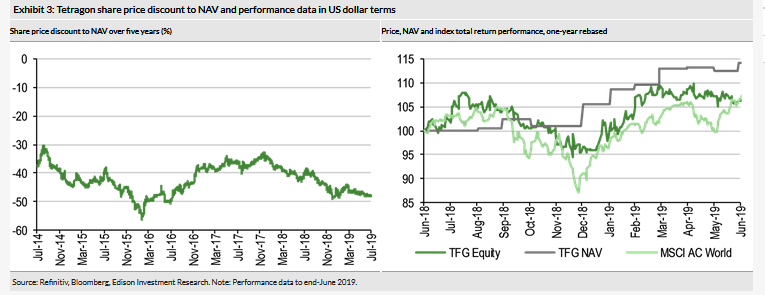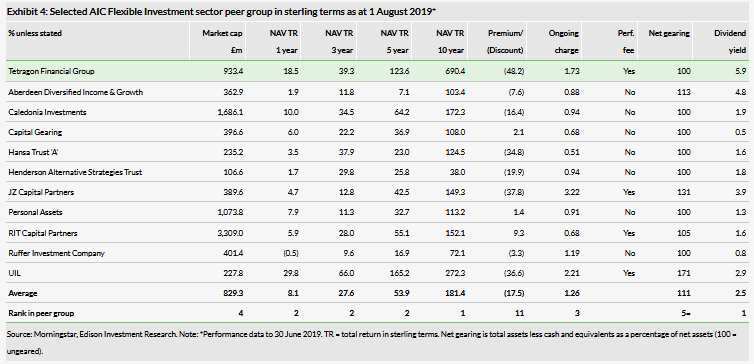Tetragon Financial Group Ltd (AS:TFG) achieved an 8.1% NAV total return in H119, with a 13.3% annualised return on equity (ROE), well within its 10–15% long-term target range. While its performance lagged global equity markets over the half year, the resilience of Tetragon’s NAV in H218 helped it to achieve a 14.3% NAV total return over the year to 30 June 2019, compared with 6.3% and -3.1% for the MSCI AC World and FTSE All-Share indices, respectively, all in US dollar terms. Despite strong NAV returns in 2019, Tetragon’s discount remains wide at 48.6%, offering significant scope for future narrowing to enhance shareholder returns, while its 5.9% dividend yield leads the AIC’s Flexible Investment sector.

The alternative asset market opportunity
Global economic growth has slowed over the past year and uncertainties such as the US-China trade dispute and the UK’s exit from the EU continue to weigh on growth prospects and stock market sentiment, while changing expectations over central bank easing and Chinese government stimulus have added to equity and bond market volatility. In the current uncertain environment, alternative assets could appeal to investors as a potential source of uncorrelated returns.
Why consider investing in Tetragon?
Scope for narrowing discount to enhance returns
Tetragon’s discount to NAV widened from 38.5% in August 2018 to the current 48.6% as the share price declined with global equity markets towards the end of 2018 (with limited subsequent rebound), while its NAV returns have strengthened in 2019. This discount provides significant scope for future narrowing to enhance shareholder returns. Tetragon’s quarterly dividend continues to progress steadily higher, and its 5.9% yield is well above the 2.5% peer group average yield.




Strong H119 performance
Tetragon achieved a strong performance in the first half of 2019, with an 8.1% NAV total return and a 6.7% return on equity (ROE) – which excludes balance sheet effects, including share dilution from the dividend reinvestment plan and value accretion from the US$50m tender offer completed in January 2019. While performance lagged broad equity market returns – the MSCI AC World and FTSE All-Share indices recorded total returns of 16.6% and 12.9% in US dollar terms in the half year – Tetragon’s returns in H119 were the strongest in the last five years, and significantly higher than its 2.7% (Libor+2.65%) incentive fee hurdle rate.
Net investment gains were US$197.2m in H119 and fair value net income was US$145.7m, which compares with US$144.6m and US$104.3m respectively in H118. Annualised ROE for the half year was 13.3%, well within Tetragon’s 10–15% pa long-term target range, and higher than the ROE achieved in each of the last five financial years (range: 6.3% to 12.1% on a like-for-like basis), although not challenging the 47.7% and 36.1% ROEs achieved in 2010 and 2011.
All asset classes in the portfolio generated positive returns in the period, except for other equities and credit, where direct balance sheet equity investments recorded an US$11.5m loss, primarily from unrealised losses on US and European single-stock positions that are still held. TFG Asset Management generated the largest net investment gain of US$91.2m, predominantly from Equitix (US$57.3m) and LCM (US$18.3m), while hedge fund strategies also generated a significant US$45.1m net investment gain, principally from the Polygon European Equity Opportunity Fund, which contributed US$41.3m from the absolute return and long bias strategies combined.
Tetragon’s net asset value increased by US$73.1m, or 3.3%, to US$2,262.5m during H119, net of the US$50.0m tender offer and US$22.3m cash dividend payments in the period. As illustrated in Exhibit 2, NAV per share rose by US$1.46, or 6.5%, to US$23.94, with the tender offer being 2.2% accretive on a per-share basis, as the shares were repurchased at a substantial discount (Exhibit 1).

Looking at the drivers behind the more significant gains in the half year, the US$57.3m gain on Equitix resulted from a combination of performance, capital raising and accelerated capital deployment. Equitix closed its Fund V at £1.0bn in Q219 – £250m higher than the original capital raising target, with the expectation that the fund will be fully invested by the end of 2019, which represents an acceleration of the business plan. This fund-raising took assets under management (AUM) to US$6.0bn, from US$5.0bn at the start of the year. In addition, the discount rate applied in the discounted cash flow valuation of Equitix was reduced from 9.75% to 9.50% in the period.
The US$18.3m gain on LCM reflected a combination of continued growth in AUM and favourable movements in market valuation metrics. AUM increased from US$8.3bn to US$9.1bn during the half year, with EBITDA up 50% compared with H118. While the discount rate applied in the discounted cash flow valuation of LCM was unchanged at 11.5%, the price to AUM multiple was moved up to 2.5%, from 2.3% at the end of 2018.
Tetragon posted a US$41.3m gain on its investment in the Polygon European Equity Opportunity Fund following the recovery from the fund’s weak performance in H218. This was assisted by corporate M&A activity, with the acquisition of the fund’s largest portfolio holding, Evry, by its competitor Tieto, announced in June 2019. Furthermore, the fund’s performance was supported by positive returns in the European markets (with the STOXX Europe 600 index up nearly 16%), especially Greek equities (Athex index was up 41.6% in H119). While the portfolio hedge attributable to the absolute return share class was a detractor in H119, a net return of 11.2% was achieved, with no down months, while the long bias share class returned a net 21.4%.
New investments, cash and borrowings
During H119, additions to Tetragon’s portfolio totalled US$154.0m, with allocations fairly evenly spread (US$24.7m to US$39.1m) across hedge fund strategies, bank loans, real estate, private equity, and direct equities and credit investments. In particular, US$32.2m was added to direct equity investments, US$30.5m to private equity funds and co-investments, and US$30.0m was added to the investment in the Polygon European Equity Opportunity Fund absolute return strategy. US$24.7m was drawn by CLO investment vehicle TCI III, while no new direct investments were made in LCM or non-LCM CLOs.
For the half year, Tetragon’s portfolio income and disposal receipts totalled US$181.0m, including US$45.5m from GreenOak Asia funds, with the realisation of the Razorback investment (a 13-storey office property in Tokyo) contributing the majority of the US$25.9m real estate gains in the period. Other significant receipts were US$48.1m from US CLO bank loan investments (primarily non-LCM CLOs), arising from natural amortisation as well as planned monetisation via optional liquidations, US$43.7m from Equitix and US$22.0m from exiting direct listed equity investments.
During the six months to end-June 2019, Tetragon’s net cash position declined by US$93.1m to US$178.2m, which represents 7.9% of net assets. This decline was largely driven by the US$50.0m share repurchase in January 2019 and cash dividend payments totalling US$22.3m. At end-June 2019, Tetragon’s future cash commitments amounted to US$193.1m, comprising hard and soft investment commitments (GreenOak US$64.3m, TCI III US$58.9m, Hawke’s Point US$44.8m and third-party private equity funds US$25.1m), with additional financial resources required to cover ongoing dividends and fees. Net investment income is expected to provide additional financial resources to fund these commitments and Tetragon also has a US$150.0m revolving credit facility in place, of which US$38.0m was drawn at end-June 2019, unchanged since end-2016.
Dividends and share dilution
During the half-year, Tetragon’s US$0.1825 per share Q418 and Q119 dividends were paid, with the total distribution amounting to US$32.2m, of which US$22.3m was paid in cash. The balance of US$9.9m was reinvested under Tetragon’s optional stock dividend plan, resulting in 0.7m shares being issued from treasury. The Q219 dividend was increased to US$0.1850 per share, continuing the historical pattern of the quarterly dividend being increased in the second and fourth quarters and held steady in the first and third quarters; this is payable to shareholders on 27 August 2019.
Tetragon’s fully diluted share count reduced from 97.4m to 94.5m during the first half of 2019. The primary contributor to the net 3.1m shares decrease was the US$50m tender offer for 4.3m shares that was completed in January 2019. This was partly offset by 0.6m shares vesting under equity-based compensation awards and 0.7m shares being issued as scrip dividends.
Discount: Moderately wider than historical averages
As illustrated in Exhibit 3 (left-hand chart), Tetragon’s share price discount to NAV narrowed steadily from its five-year wide point of 56.3% in February 2016 to 32.8% in December 2017, but has subsequently followed a widening trend. While the current 48.6% discount is appreciably wider than its three- and five-year narrow points of 32.8% and 30.3%, it is only moderately wider than its one-, three-, five- and 10-year averages of 45.0%, 41.0%, 42.2% and 41.0% respectively. Exhibit 3 (right-hand chart) clearly illustrates the divergence between Tetragon’s share price and NAV total return performances from August 2018 to December 2018, when Tetragon’s share price broadly followed the decline in global equity markets (although to a lesser extent), in noticeable contrast to the stability of its NAV over the period. This serves to highlight the uncorrelated nature of the returns that can be achieved by Tetragon’s diversified alternative asset portfolio relative to equity markets.

Peer group comparison
Exhibit 4 shows a sterling-based comparison of Tetragon with the other 10 members of the AIC Flexible Investment sector that have a market cap of more than £100m. The investment mandates of the peer group funds vary widely, with none serving as a direct comparator for Tetragon, but the peer group average provides a broad context for comparison. Tetragon’s NAV total return is clearly ahead of the peer group average over one, three and five years to end-June 2019, and more than double the return of the second-ranked fund over 10 years. US dollar strength versus sterling (+3.7%, +5.0%, +34.3%, +29.4%, respectively over one, three, five and 10 years to end-June 2019) had a positive effect on Tetragon’s performance in sterling terms over all periods shown.
Despite its near- and long-term relative outperformance, Tetragon’s share price discount to NAV is the widest in the peer group. Several other funds are also trading at substantial discounts, while three of the peers are trading at a premium to NAV. Tetragon’s ongoing charge is among the highest in the peer group and it is one of four funds that charge a performance fee. Similar to the majority of its peers, Tetragon has no corporate level net gearing. Helped by the recent widening of its discount, Tetragon’s dividend yield has risen to 5.9%, which is the highest in the peer group, more than double the 2.5% average yield. We note that if Tetragon’s discount was to fully unwind, its shares would yield c 3.0%, which would rank third highest in the peer group.
